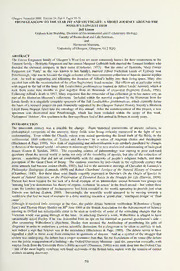
From Glasgow to the Star Pit and Stuttgart: a short journey around the world's longest fish PDF
Preview From Glasgow to the Star Pit and Stuttgart: a short journey around the world's longest fish
GlaFsRgoOwMNatGurLalAisSt2G00O6W.VTolOumTeH2E4.SPaTrtA4R.PPaIgeTsA59N-7D1S.TUTTGART:ASHORTJOURNEYAROUNDTHE WORLD’SLONGESTFISH JeffListon GrahamKerrBuilding,DivisionofEnvironmentalandEvolutionaryBiology, FacultyofBiomedicalandLifeSciences, and HunterianMuseum, UniversityofGlasgow,Glasgow,G128QQ ABSTRACT TheFerrierFergussonfamilyofGlasgow’sWestEndaremorecommonlyknownfortheirconnectionstothe Tennantfamily-HenriettaFergussonandhercousinMargaretGalbraithbothmarriedtheTennantbrotherswho foundedthechemicalcompanyintheirname(Crathome, 1973). ButthesisterofHenrietta,MaryFerrier Fergusson(or‘Ferry’ asshewasknowntoherfamily),marriedAlfredNicholsonLeedsofEyeburynear Peterborough,whowastobecomethesinglecollectorofthemostextensivecollectionofJurassicmarinereptiles ever. AswellassupportingandtoleratingtheinvasionofAlfred’shobbyintotheirlivingspace,Maryalso assistedhimwiththereconstructionoftheoftenfragmentaryfossilremains. Hereffortsareinparticularnoted, withregardtothetailofthebonyfishLeedsichthysproblematicus(namedinAlfredLeeds’honour),whichit tookthem somenine months to glue together from its thousands ofexcavated fragments (Leeds, 1956). FollowingAlfred’sdeathin1917,Maryrequestedthattheremainderofhiscollectiongotohernativecity,as partoftheHunterianMuseum’scollections. IncludedwithinthematerialacquiredbytheHunterianfromthe LeedsfamilyisasingularlycompletespecimenofthefishLeedsichthysproblematicus,whichcurrentlyforms thebasisofaresearchproject(inpartfinanciallysupportedbytheGlasgowNaturalHistorySociety’sBiodwen LloydBinnsBequestfund)intotheosteologyofthisanimal. Afterthecommencementofthisproject,anew specimen was discovered near Peterborough, which has been included within the scope ofthis work. Nicknamed‘Ariston’,thisspecimenisthefirstsignificantfindofthisanimalinBritaininninetyyears. INTRODUCTION The nineteenth century was a crucible for change. From historical assessments ofancient cultures, to philosophical viewpoints oftheuniverse, many fieldswerebeingcriticallyreassessedinthe lightofnew understanding. EvenwithintheChurch,voiceswereraisedquestioningtheliteraltruthoftheBible,inthe controversial 1860 collection of ‘Essays and Reviews’ by a series ofAnglican clerics and theologians (Blackmore&Page,1989). Newfeatsofengineeringandindustrialisationweresimilarlyparalleledbychanges intheoriesofthenaturalworld-advancesinmicroscopyhadledtonewstudiesandunderstandingofbiological tissues(Liston& Sanders,2005). Theexpandingscienceofpalaeontologywas startingtoposeawkward questionsaboutthenaturalworldintermsnotonlyofthemutabilityofspecies,butalsooftheextinctionof species-somethingthatdidnotsitcomfortablywiththemajorityofpeople’sreligiousbeliefs, andtheir perceptionoftheGreatChainofBeing. Thecautiousassertionbyindividualsintheeighteenthcenturythat someanimalshadbecomeextinct(Rolfe,1985),hadledtotheinstinctivestrivingsofChevalierdeLamarck’s PhilosophicZoologique(Lamarck, 1809)andRobertChambers’ VestigesoftheNaturalHistoryofCreation (Chambers, 1845). ButtheseideaswerefinallycogentlyexpressedinDarwin’sOntheOriginofSpeciesby meansofNaturalSelection,orthePreservationofFavouredRacesintheStruggleforLife(Darwin, 1859). Darwinhadbeenberatedforthelackofafossilexampleofanintermediateanimalbetweentwogroups(or ‘missinglink’)todemonstratehistheoryoforganicevolution‘inaction’inthefossilrecord-butwithinthree yearstheLondonspecimenofArchaeopteryxhadbeenrevealedtotheworld,appearingtoprovidejustwhat Darwinwas lacking (Liston, 2000). Increasingly, the scientific world appearedto be moving towards a worldviewthathadnoneedofrecoursetoadeityworkingtowardsa‘grandplan’,‘intelligentdesign’or‘final cause’. Althoughitreceivedlittlecoverageatthetime,thepublicdebatebetweenArchbishopWilberforce(‘Soapy Sam’)andThomasHenryHuxleyon30“'June1860attheBritishAssociationfortheAdvancementofScience meetinginOxfordhassubsequentlycometobeseenassymbolicofsomeofthewrenchingchangesthatthe Victorianworldwasgoingthroughatthetime. InattackingDarwin’swork,Wilberforceisallegedtohave sarcasticallyaskedHuxleyifhewasdescendedfromanapeonhismaternalorpaternalgrandparent’sside- aftercounteringWilberforce’s objections, Huxleythen accusedtheArchbishop ofprostitutinghis giftsof eloquenceinordertoundermineaseriousscientificdiscussion:foraclergymantobetakensopubliclytotask wasindeedasignthatSciencewasintheascendancy(Blackmore&Page,1989). Thedebateseemstohave signalledashiftinfocusawayfromextinctiontoquestionsofdescent. Andasasymbolofthestrugglethat societywasundergoing,thedebatehasadeeperresonancethanthat,forthefoundationsofitsvenue(thedebate wasthepublicinaugurationofabuilding-theOxfordUniversityMuseum-paidfor,somewhatironically,with surplusfundsfromtheUniversityPress’sBibleaccount!(Thomson,2000))weresunkdeepintotheOxfordClay -oneofthemosthighlyvertebraterichfossilsedimentsoftheBritishIsles,repletewiththeremainsofextinct animalsawaitingdiscovery. 59 THEOXFORDCLAY TothenortheastofOxford,butstillwithinthissamerichfossiliferoussediment,wasageographicalareain whichgreatsurgesinknowledgeofancientanimallifeweretobesymbioticallylinkedwithparallelindustrial development-theFenlandaroundPeterborough. ItbeganwithanauctionedsaleoflandaroundFletton(just southofPeterborough)-400acresweresoldon23/6/1877,andaseriesofindividualsfromadiversegroupof tradesdecidedtotrytheirhandatproducingbricksfromthe‘brickclay’ofthisland. Withinfouryears,ithad beennotedthatthedeeperclayofthePeterborougharea(theLowerOxfordClay,lyingbeneaththesuperficial callowclaymoretraditionallydug)hadanextremelyhighorganiccontent,whichmeantthatnoadditionalcoal orcarbonwasneededtobeimportedtofirethebricks-inessence,this‘claythatbums’wasself-firing,andin removing the need for the additional expense ofshipping in coal for the kilns, Fletton bricks became significantlycheaper,andthushugelypopular. Itwasthisthatchangedthetrendofclaydiggingfrombeinga small-scale(oftenfamily-based)seasonalbusiness,toalarge-scaleyearroundindustrialisedprocess. This meantthatevenmorelandaroundPeterboroughcameupforsale,andthelandscapewasswiftlytransformed, withforestsofkilnchimneysstrewnacrossthelandscape. Althoughinitiallyexcavatedbyhandwithteamsof menwielding2metrecrowbars,thisgraduallygavewaywiththeriseindemandfrom 1890toindustrial machineryandmechanicalexcavators,whichmoreorlessdominatedthefewpitsthatremainedactiveduring theGreatWar(Hillier,1981). Byandlarge,itisessentialforhuman(ratherthanmechanised)diggerstobeemployedtodigtheclay,inorder toobservefossilsastheyappearandpreventthemfrombeingdestroyedduringclayexcavation-asnotedbythe renownedpalaeontologistW.E.Swinton(intheforewordtoLeeds,1956).Fromthispointofview,theoptimum historicalperiodforretrievaloffossils,isdefinedbythepeakperiodofclayexcavationfollowingtherealisation thattheLowerOxfordClayisanexceptionallyusefulforbrickmanufacture(circa1881),untilthetimethatthe industryswitchestobeingfullymechanised,aroundtheendofthewar(Leeds,1956). Throughoutthisperiod, onekeyfigurewasabroadinPeterborough,collectingthemarinefaunafromtheJurassicseabedsrepresentedby theOxfordClay. Hehadcollectedsuchmaterialinearlieryearspriortolarge-scaleexcavation,andnowhewas poisedtotakeadvantageofthewealthofnewmaterialbeinguncoveredeverydaybythearmiesofclaydiggers nowemployedintheregion. HisnamewasAlfredLeeds. ALFREDNICHOLSONLEEDSANDMARYFERRIERFERGUSSON OnTuesday19thOctober,1875,amarriagetookplaceat11,GrosvenorTerrace(Fig.1),Glasgow,betweenthe youngdaughterofcitymerchantAlexanderA.Fergusson,andAlfredNicholsonLeedsFig.2),agentleman farmerlivingonthefenseastofPeterborough. MaryFerrierFergussonwasembarkingonaweddedrelationship withamandestinedtobecomeoneoftheworld’sgreatestcollectorsoffossilJurassicreptiles. Shewouldalso be,inequalpart,apreparatorandconservatorofthebonesoftheseanimalsfromtheMiddleJurassicOxford Clay. Inthetwentyfifthyearoftheirmarriage(asrecordedbythesecondoftheirfivesons,EdwardThurlow Leeds(Leeds,1956)),theyspentninemonthsincleaningandgluingtogetherthemanythousandsoffragments thatmadeupthetailofwhatwascertainlythelargesteverbonyfish,Leedsichthys,namedinhonourofher husband(Fig.4). Herpalaeontologicalcontributionthuswentfarbeyondtheperhapstypicaloneofthewifeofa palaeontologistinthenineteenthcentury,becausebeyondsimplytoleratingthearrayofdrawersofbonesstrewn aroundthemanyroomsoftheirhouseinEyebury(Fig.3)(eastofPeterborough)whiletheywerebeingworked onbyherhusband,shewasanactivesupporterandcollaboratorinhiswork. Indeed,whenAlfredLeedsdiedon the22"'^August1917,itbecamenecessaryforthefamilytoleaveEyeburysoonafter,andsoshetookahandin thefinaldisposalofthelastaccumulationofhiscollection,expressingthewishtoThurlowLeedsthatthe remainderofthecollectionofherdeadhusband(some450marinereptilespecimens),passintothecareofthe UniversityofGlasgow,hernativecity. ThisledtotheUniversityofGlasgow’sHunterianMuseumbecoming theownerofthelargestcollectionofJurassicreptilesfromasinglecollectorinBritain,secondonlyinsizetothe BritishMuseum(NaturalHistory),London. Thiswasaprodigiousachievement:althoughtheBritishMuseumhad,duringAlfred’slifetime,beenthemain beneficiaryofhiscollecting,havingfirstrefusalonanyofthematerialthathefound,mostofthematerialthat theBritishMuseumhaddeclinedhadpassedthroughthehandsofthedealerStiirtzofBonn(between1897and 1911),tospreadnotsimplythroughoutEurope,butaroundtheglobe(Leeds,1956). TheHunterian’sacquisition ofthisfinalbulkcomponentofhiscollectionmeantthat,innumericaltermsatleast,theHunterianheldthe largestsinglecollectionofAlfredLeeds’materialintheworld. Bythetimeofthispurchase,theHunterian Museum,alongwiththerestoftheUniversityofGlasgow,hadmovedfromitsOldCollegecitycentresiteinto Glasgow’sWestEnd,some5minuteswalkfromwhereAlfredandMaryhadmarried,inMary’sfamily’shome of11,GrosvenorTerrace,attheheadofByresRoad. Thismeantthatforanyfuturetripsshemadetoseeher familyinGlasgow,the Museumholdingthecollectionfromovertwentyfiveyearsofherlatehusband’s collecting,wouldbenearathandtovisit-andindeedtheHunterianMuseum’svisitorbooksrecordoneofher visitsonthe21"'September1915. Priortothisfinalsale,however,someconnectionshadalreadyexistedbetweenAlfredLeedsandtheUniversity ofGlasgow. AfewmodestbatchesoffossilmaterialhadalreadybeenboughtfromLeedsbyProfessorJohn WalterGregory(seeFig.5),theHeadoftheGeologyDepartment. Gregoryappearstohavefirstcomeinto contactwiththeLeedsCollectionwhenhestartedworkasanAssistantintheGeologyDepartmentoftheBritish 60 Museum(NaturalHistory)in1887(Longwell,1933),duringtheperiodinwhichtheinitialbulkpurchase(The FirstCollection’)fromAlfredLeedswasarrivinginthatestablishment(Leeds,1956). Gregorylaterbecamethe firstincumbentoftheChairofGeologyatGlasgowUniversityin 1904. WiththatpostcametheHonorary Curator-shipinGeologyfortheUniversity’sHunterianMuseum,anditwasafterthisthathearrangedthe purchasesfortheHunterian’scollections. Includedwithinthesewerearemarkablycompleteskeletonofthe ichthyosaurOphthalmosaurus,(assembledbyAssistantCuratorWilliamRobertSmellie,Fig.6,sothatitwason displayintheHunterianMuseumfromaround1916untilthe1970s,seeFig.7),andwhatlaterturnedouttobe themostcompletespecimenofLeedsichthysevercollected(Liston,1999). Nownicknamed‘BigMeg’(Fig.8), thisspecimenwasfirstnotedbyAlfredLeedsinalettertoArthurSmithWoodwardinFebruary1913(Leeds, 1913)(Fig.9,Fig.10),andwassoldtotheUniversityofGlasgowinFebruary1915(Liston,2004). Giventhat AlfredLeedshadtraditionallyofferedfirstrefusalofallhisspecimenstotheBritishMuseum(NaturalHistory) inLondon,itmayseemstrangethattheBM(NH)didnottaketheopportunitytopurchasethisspecimen,asit cdooncsuimsetnetdaotfiomnorinetthheanNtHwMiceaptpheearqusantotiitnydiocfatmeattehraitalthaesythhaedirbhooulgohttypaessupbestcainmteianl(sBpeMcNiHmenP6f9r2om1),AlbfurteadrcLheievdasl 2s0o0m4e;fLiifstteeonny&eaNrosee,ar2l0ie0r4)-.aIsnptehceimleignhtthoafttnhiosw,i(tdiessppietrehaitpsssiuzned)ercsatnannodtabbleeetnhtaitretlhyecBonMfiNdeHntmliyglhotcahtaevde(Lleitsttohni,s particularfish‘getaway’toGlasgow. ‘Meg’iscurrentlythecorespecimenofaresearchprojectbasedattheUniversityofGlasgow,investigatingthe virtuallyundescribedosteologyofLeedsichthys. Tosupportthisresearch,virtuallyallknownspecimensofthis taxonhavebeenloanedtoGlasgow,aloanthatwasmadefinanciallypossiblethroughagenerousgrantfromthe GlasgowNaturalHistorySociety’sBlodwenLloydBinnsBequest. Thebonesofthisanimalarerenownedfor beingextensive,crushed,brokenandfragmentary. In1889,ArthurSmithWoodwardmadetentativeattemptsto understanditsskullosteology(Woodward,1889a,1889b,1890),butadmittedeightyearslaterthatbeyondthe fin-raysofthetailandthesevenandahalfcentimetrelonggillrakers,thatnobonehadbeensatisfactorily identified(Leeds&Woodward,1897). Itisbelieved,becauseoftheunsegmentedandbifurcatingnatureofthe finraysinitstail,thatthisfishisamemberoftheFamilyPachycormidae. Indeed,in1916(Woodward,1916), ArthurSmithWoodwardhimselfstatedwithsomeexcitementthathecouldseearesemblancetoLeedsichthys b(oBnMesN“HinPmIi1n1i2a6t,urFei”g.in11t)h.e1A.r5gmueatbrleyltohnegbsepsetcciomlelenctoifotnheofpaJucrhayscsiocrmfiosdsiSlaufirsohsstpoemcuismfernosmliteheinHothlezmmaudseenumsshalien GermanywithsubstantialmaterialfromtheHolzmadenPosidonienschieferorlowerJurassicshaleofsouthern Germany,andsoacollectionvisittothesemuseums(again,generouslysupportedbyagrantfromtheGlasgow NaturalHistorySociety’sBlodwenLloydBinnsBequest)becameanessentialpartofthestudy. Whytrytoseealargenumberofspecimens,asopposedtoonewell-preservedindividual? Thereareanumber ofreasonswhyacomprehensiveattempttoseeasmanyspecimensaspossibleofthisfamilyofbonyfishes wouldbevitaltounderstandingtheskeletalanatomyofLeedsichthys,butthecentraloneisthis:theskullbones ofthesepachycormidsaresothinandinterlockandoverlaptosuchadegree,thatindividualbones(suchas remainofLeedsichthys)areextremelyhardtodiscern: itisnosurprisethatifonelooksatthesmallerbut apparently related genus ofSaurostomus from the Holzmaden shales that its skull bones are like silk handkerchiefs,sothinthatitishardtotellwhichboneislyingontopofwhich(Fig.12). Itisthusonlythrough examiningspecimensshowingskullsinwidelydifferingdegreesofdisarticulation,thatindividualbones(and theiroriginswithintheoverallschemeoftheskull)canbedetermined. Thus,afterafewinterestinghintsfrom otherinstitutionsacrossGermany(inparticularinMiinchenandTubingen),itwasoflittlesurprisethatthemost importantcluestotheidentitiesofsomeofthegiantskullbonesofLeedsichthyscamefromtheremarkable Staatliches Museum fur Naturkunde in Stuttgart, with its many specimens of both Pachycormus and SaurostomusfromtheHolzmadenshale. Forthefirsttime,asaresultofthisexamination,itwasclearthat bonesextremelysimilartothemaxillary(Fig.13)anddentary(Fig.14)bonesofSaurostomuswerepresentin largeforminsomeoftheremainsofLeedsichthys(Fig.15,16). ButamoredirectaidtotheunderstandingoftheskeletalanatomyofLeedsichthyshadalsocometolightinthe interim. LEEDSICHTHYS-ANEWSPECIMEN InJuly2001,1receivedabonethroughthepost. Notanentirelyunusualeventinitself,thisbonewouldturnout tobesomethingquitespecial. IthadbeenfoundbyaPortsmouthPalaeobiologyundergraduate(Martill,2002), workinginoneofthemanybrickpitsaroundPeterboroughthatexcavatetheOxfordClaytomanufacturebricks (Dawn,2004). Thestudent,MarcusWood,hadcomeacrosstheboneprotrudingfromafacethathadnotbeen workedbytheshaleplanersincetheearlynineteeneighties. Anotherstudentonthecourse.MattRiley,looked atthefaceindependently,andsawanumberofsmallerbonesprotrudingfromthesamebed. Fortunately,their coursesupervisor.Dr.DavidM.Martill,wasalso,incollaborationwithDr.ColinAdamsoftheInstituteof BiomedicalandLifeSciences,UniversityofGlasgow,co-supervisingmypostgraduateresearchonthegigantic JurassicfishLeedsichthys,andsoknewtosendthebonetomeforidentification. Iwasablenotonlytoconfirm hissuspicionthatitwasindeedLeedsichthys,butalsotostatethatitwaslikelytobeadorsalfinspine,ofthe kindmistakenlyidentifiedbytheGermanpalaeontologistVonHueneasbeingatailspinebelongingtothe stegosauriandinosaurOmosaurus(nowLexovisaurus)(Huene,1901)(seeFig.17). 61 TheStarPitatWhittlesey(coincidentallyonethatAlfredLeedshadhimselfcollectedfromsome90years before)wascomingtotheendofitsworkinglife,producingclayfortheHansonBrickCompanytoturninto bricks. Thismeantthatifadigweretobeorganised,itcouldberunwithoutthehealthandsafetyissues surroundingtheexcavationofmaterialinthesamepitasactiveshaleplaners,whichcouldprovepotentially dangerous. Dr.Martillandmyselfmadeplans,andeventuallyvisitedthesiteonthe22"^October2001,together withAlanDawnofthePeterboroughCityMuseum,toassessthesignificanceofthefindandthepotentialofthe site. Wehadmixedresultsfromtheassessment-onthepositiveside,wecouldconfirmthat,asMattReillyhad indicated,therewere13smallbonesprojectingfromthecliff,overan8.5metrestretchofthesamelayer(Bed 14(Hudson&Martill,1994))astheonethathadyieldedthelongerdorsalfmspine(Fig.18). Giventherange insizesoftheprojectingbones,andthattheremainsseemedrelativelyconcentratedforafishestimatedtogrow anywherefrom 10(Woodward, 1917)topotentially27.6metres(ashintedatinthecaseofoneexceptional partial setofremains(Martill, 1986)),itseemedthatlittletransportationordisruptiontotheskeletonhad occurred. Thisappearedtoindicatethatamajorfind,aslargeasanyspecimensofarrecovered,washidden withinthecliff Onthenegativeside,anexcavationcouldnotbeconductedparticularlyfarintoabedwith20 metresofoverburdenwithverymuchsafety. Andgiventhesizeofthefish,bothDaveandIknewthatitwas likelythatasubstantialareaofthecliffwouldhavetoberemovedtobeconfidentthatwehadachanceof recoveringeverythingthatwebothfeltmightwellbethere. Itwasclearthatthiswouldrequireaheavypieceof excavatingmachinery,andthiswouldnotbecheaptohire. Intheworstpossiblecasescenario,wemightendup spendingalargeamountofmoneytoremoveacliffsome20metres(50feet)inheight,onlytofindthatthe fragmentsthatwecouldseetheendsof,wereallthatwasleftofthefish-theresthavingbeenremovedinthe early1980sandturnedintobricksperhapsusedforabathroomextensioninNorfolkinthenineteeneighties. Butthisseemedtheleastlikelyresult. Whatwasvirtuallycertainwasthatwehadthemostsignificantfindof thisfishsince(accordingtoNaturalHistoryMuseumarchives)February 1913(Leeds, 1913),andwhatwas extremelylikelywasthatwithinthecliffwasprobablythemostcompletespecimenofthefisheverfound. Whatmadeattemptingtoexcavatethespecimenallthemoreworthwhile,wasthatonehadneverbeenexcavated undertherigouroffullscientificprocedures,withmappingoftheremainsbeforetheycameoutoftheground. TheclosesttomappedindicationsofhowthebonesofLeedsichthyshadbeenfound,weresomedoodled sketchescontainedinaletterfromthecollectorAlfredLeedstoArthurSmithWoodwardoftheBritishMuseum (NaturalHistory)inLondon(Leeds,1898),andaroughscale-lesssitemapmadeupretrospectivelybyagroup ofGermanteenagers (aswellasPeterborough,theremainsofthefishhavealsobeenfoundinNormandie, northernGermany,andChile)analysingfifteenyearsworthofphotographsthattheyhadtakenduringtheirdigs (Probst&Windolf,1993;Michelisetal,1996). Evenifwedidprovetobemisguidedinourexpectationsofthe completenessofthisnewspecimen,thevalueofthefirstproperlymappedrecordofthebonesofLeedsichthysas found,couldbeimmeasurable. Therarityofsuchanopportunitywastoogreattopasson,andbyMay2002Dr.Martillhadraisedtheinitial fundingfora2-weekdig,ledbymyself,scheduledforthefollowingmonth. Dr.Martillwouldhaveledthedig himself,butforhisintensiveworkscheduleforthatsummer. Personally,myschedulewasalsobusy-Ihada long-plannedtourofcollectionsinGermanybookedforJuly-butgiventhequantityofbonelikelytobe excavated(basedonthequantityofmaterialcomprisingthemostcompletespecimencurrentlyknown,the specimennicknamed‘BigMeg’intheUniversityofGlasgow’sHunterianMuseum),theplannedtwoweeks wouldbeadequatefortheexcavationnecessary. Unfortunately,paperworkproblemsdelayedourstartingdate, sothattheheavyexcavator,a21 tonneKomatsu,couldonlygetaccesstothesitestartingonthe24'*’June (Martill&Liston,2003). Ittookfullyfivedaysfortheextremelyskilleddriver,DavePeppercorn,toremovethe 20-metreoverburdenfromaroughly25metreby9-metreareaofthebed(Fig.19). Hewasabletostriptheclay bedsbacktoayellowshellbedlayersome8cmabovethebonelevel(Dawn,2002),shiftingsome10,000tonnes ofmaterialintheprocess,someofwhichwenttoformaplatformandslopethatourvolunteerdiggerswould laterusetoworkon. TheskywasdarkeningwhentheKomatsuexcavatorfinallyleftthesiteattheendofthatfirstweek,itsjobdone (Fig.20). Iremainedtoguardthedigovertheweekend,toensurethatnoopportunisticcollectorstriedto scavengematerialfromanabandonedsite,whileDr.Martillwenttocollecthisundergraduatevolunteerdiggers fromPortsmouthUniversityforthefollowingMondaymorning. Iwasable,inthefresh8amdaylightofthat firstSaturdaymorning,togodowntothenewlyexposedbed,starttoexcavatefromtheedgeofthecliff,and takestockofwhatweactuallyhad. Iwillneverforgetthatinitialperiodofexcavation,seeingtheenormous densityofbone,farinexcessofwhatwehadseenprotrudingfromtheedge,andwaybeyondourexpectations. Itwasclearthatwehadatleastoneverycompletelypreservedsectionofthisfish(Fig.22). Somefaulting withinthecliff(resultingfromslippageofthecliffafterbeingworkedbytheshaleplanerintheearlyeighties) meantthatthebonemightbelimitedtothatfirstarea(Fig.21),butstillthequantityofbonerecoveredhad alreadymadetheexpenditureontheexcavatorworthwhile. Twodaysintothefollowingweek,Iwasalreadyrunningbehindscheduleformyplanneddepartureforthe collectionstudytrip(includingthevaluableandsuccessfulvisittoStuttgart,mentionedearlier). Despitemy reluctancetoleavethedigatthisearlystage,itwasclearthatIhadtogo. Dr.Martillwouldtakeoverasacting digleaderinmyabsence,anddespiteourjointexpectationthatever34;hingwouldsoonbefinished,hegaveme anundertakingthatifsomewell-preservedandassociatedskullmaterialstartedappearing,hewouldensurethat 62 itwasleftandnotlifteduntilIhadreturnedandseenitinplace.Butwewerebothwrong. When1returnedthree weekslater,bonewasstillbeingexposed,withlittlesignyetofanythingthatmightbeskullmaterial,oranend tothebonematerialbeingrevealed. Theproblemwasnottheusualoneondigs,ofdifficultyinfindingbone, butthat‘toomuch’bonewasbeingfound-oftendiggerswouldcomplainabouthowtheyyearnedforareasof claydevoidofbone,sothattheyknewthatatleastinoneareatheyhadcometoanendofthepreservedremains. TheproblemsofexcavatingthematerialhadgrownoverthedaysthatIhadbeenaway. Contrarytoappearances whenthebedwasfirstcleared,thetopographyoftheclaylayerdidundulateslightly-andanincautioushand couldaccidentallygothroughbone,especiallyassomeelongatedrod-likecomponents seemedtobe long enoughtolieproudofthesoftclaylayerthatthebulkofthebonewasheldwithin,sothatitprojectedintothe harderslabsoftheoverlyingbed. Thesetopographicalproblemswerecompoundedbyadegreeoffaultingcriss- crossingthroughthebedthathadbecomeapparentwhentheshellbedhadbeenremovedduringearlyhand excavation. Althoughthesefaultsdidnotappeartorundirectlythroughmanybones,andthethrowwasnottoo significant(itwasnevertoofarfromthebrokenendofonepartofabonetoitsmatchingbrokensurfaceinan opposingblock), this still added complicationswhichmightagain leadunwaryexcavatorsto accidentally excavatethroughbone. Therewasacoreareaofbonethatraninanareaabout14metresby8,andwithinthat thereweremanyareasthatweremulti-layered,sothatafteronelayerofbonehadbeenexposed,mappedonto largeplasticsheetsandremoved,anotherlayercametolight. Thiswasparticularlyproblematicandtime consuminginanareachristened‘GreenBay’(namedafterthecouplethatdedicatedlyexcavatedit,Peterand MargaretGreen,oftheStamfordGeologicalSociety)thatwasdenselyfilledwithgillrakers,andultimatelythis couldonlyberesolvedbyremovingroughly7cmdeepslabsofthearea,inthehopeoffullexcavationatalater dateinlaboratoryfacilities. Alsoproblematicwastheboneitself,whichbaffledseasonedexcavatorsofOxford Clayreptileswithovertwentyyearsexperience,whowereentirelyunpreparedforafossilanimalwithsomany bonesthatwereoftensothinanddelicate,yetsometimesexceptionallylargeandalwaysincrediblyfragile. This causedparticularproblemswhentrenchingaroundsomeofthelargerbonesforplasterjacketing,astherewould oftenbedozensofsmallerboneslyingaroundtheperimeter,whichcouldunwittinglybedestroyedbythe incautiousdigger. Theclayneededtobeparedawayfromthebonesusingdentaltools-painstakingandtime consuming,buttheonlywaytosafelyreleasethebonesfromthismatrix. Traditionalmethodsofapplying ParaloidB72conservationgluehadtobedistinctlyrefined-althoughonecouldgetawaywithapplyingthick mixesofthissubstancetoreptileboneinthefield,withthisfossilfish,thegluesimplyobliteratedtheboneand madeitextremelydifficulttoliftfromtheclay. Andyet,incontrast,ifthebonedidnotreceiveParaloidB72 verysoonafterbeingexposedtotheair,itwoulddesiccateandstarttobreakdownwithinacoupleofdays. This wasaparticularlysignificantprobleminthefirstfewweeksofthedigwhenlargeareasofbonewerebeing exposedfasterthantheycouldbeprotected,andtheweatherwasfluctuatingbetweenintenseheatandheavy downpoursofrain,whichalternatelybakedandfloodedthesite(seeFigs.23-25). Althoughallofthesefactorswerepartofanelaboratelearningcurveforallinvolved,theyalsomeantthat,in conjunctionwiththequantityofbonebeingwayinexcessofwhatwaspredictablefromexistingmaterial,they massivelyincreasedtheamountoftimethatthedigtook. ThenewspecimenofLeedsichthyssoonacquiredthe nicknameof‘Ariston’,becauseitsimplywent ‘onandon’ (astheoldcommercial advertisementusedto declare). Thisunpredictabilityintermsofquantityofmaterialmeantthatnumbersofpeopleavailabletodig dwindledwhenthelargestamountofbonehadtobelifted-afterthe26'*’July,thecoreteamdroppedtojust threeindividualsasdedicateddiggersonthesite. Eventually,thesitehadtobeclosedonThursday26'*’ September,notbecauseallthebonehadbeenremoved,butfortworathermorepragmaticreasons. Firstly,the universitytermwasabouttocommence,whichmeanthatthediggers(bothstudentsandstaff)neededtoreturn totheirvariousinstitutions. Secondly,theHansonBrickCompanyneededthePortakabinbackthattheyhad kindlylentusoverthesummerinorderthatwecouldstorethecollectedspecimensin. Bothofthesefactors meantthatitwastimeforthesitetobeevacuatedforthatfieldseason. Aninetonnetruckwashiredforthe mammothjoboftransportingallofthemanyhundredsofclayandplasterblocksintomorelongtermstorage (Fig.26). InAugust2003,asmallgroupofdiggersreassembledattheStarPit,tocleartherestofthebonesfromthe exposedbed,forthreereasons:firstlytoensurethattherewasnoopportunityforindividualstoplunderbones fromthebedafterthebroadcast(plannedforamonthlater)ofatelevisionprogrammereportingtheexceptional find(Dawn,2004);secondlytoassessthedegreetowhichboneswerecontinuingintothecliff,andwhetherit wasthereforeworthremovingmoreofthecliffinthehopeofretrievingmoreofthesamespecimen;andthirdly toensurethatshoulditprovenecessarytobringbackaheavydiggertotakethecliffbackfurther,thatthere wouldbenodangerthatbonesleftinplaceontheexcavationbedwouldbedamagedbythediggerreturning. Fortwoweeks,theseindividualslabouredtocleartheremainderofthebone,supportedbythePalaeontological AssociationandtheNationalMuseumsofScotland,withinasmallwindowoftimeformedbytheavailabilityof individualstoworkwithoutjeopardisingtheirownsummerprojectwork. Theworkwasmadehardbythe impactofwinterweather,whichhadhomogenisedtheupperstrata,makingitdifficulttodistinguishandseparate themduringexcavation-the ‘pen-knife’ excavationbelovedofthepreviousyearwasnolongerpossible. Followingthis,theonsetofsummerhadreducedthesurfacelayerstofineflakesofshale,whichwasdifficultto removecleanly. Bytheend,thesitehadbeenclearedtoadegreesatisfactorytothediggers,andplanswerein placeforremovalofthecliff Itisplannedthat,dependingontheavailabilityofmyselforDr.Martill,thecliff 63 removalwillnottakeplaceuntilthestartofthenextfieldseason(2006)-partlysothatftirtherboneswillbe securedsafefrompotentialprivatecollectorswithinthecliff,andpartlybecausetheenvironmentalprotectionof 20metresofclayontopofabedisinvaluable:afreshbedrelativelyunaffectedbyweatherwillbeconsiderably easiertoworkthanonewhichisexposedtotherigoursoftheFenswinter. Whathavewelearnedfromthisremarkablefish specimen(registeredwithPeterboroughCityMuseumas PETMGFI74)-adiscoveryalreadydescribedasthemostimportantBritishvertebratefossilfindsincethe dinosaurBaryonyxwasexcavatedin 1983? Thespecimenisexceptionalinanumberofimportantrespects, includingquantityofmaterial(over2,300bonescollectedbytheendofthe2003fieldseason,seeFig.27),the presenceofpairedbonesforthefirsttimeinaspecimenofLeedsichthys,andremarkableclarityofskeletal growthstructuresonmanyofitsbones,fromgill-rakerstohyomandibulaeandfinrays. Someofthesegrowth structuressuperficiallyresemblegrowthrings,whichholdoutsomepromiseofyieldinggrowthdataforthis animal. Withgreatoptimism.Dr. Martillandmyselfhadhopedforsomesignofstomachcontentsasan indicatorofdiet:thefishhaslongbeenregardedasanedentuloussuspensionfeederlikeabaleenwhaleora baskingshark,inpartbecauseofitsunusuallylarge(over7.5cminlength)gill-rakersintheabsenceofany teeth,butsomepreservedevidencefromitsgutwouldhelptoremoveanyambiguityoverthis. Itrapidly becameclearthatthecomponentoftheskeletonthathadbeenpreservedwithinthecliffwouldnotcontainthis regionofitsbody(thatappearstohaveendedupaspartoftheaforementionedhypotheticalNorfolkbathroom extension),butsomesmallfishvertebraewerepreservedwithinthecentralmassofgillrakers,whichmight serveasanindicatorofsomeofthepreyitemsthatLeedsichthys(perhapsinadvertently)fedupon(seeFig.28). Inadditiontotheretrievedremainsthemselves,andofequivalentimportance,isthedocumentation-adetailed seriesofplasticmappingsheets(roughly6x2metreseach-seeFig.29),papermaps,fieldnotesandahostof digitalimages,allofwhichmakeitpossibletorecreatethedispositionofthebonesastheywereoriginally found. FundingiscurrentlybeingsoughtfortheHerculeantaskofpreparingtheboneoutoftheclayslabscollected- anestimatedtaskofoneandahalfpersonyearsinduration,tofullycleanthemorethan2,000bonesthusfar collected. Intheinterim,AlanDawn,theboneplastererparexcellenceofPeterboroughCityMuseumand StamfordGeologicalSociety,hasbeenworkingatcleaningoccasionalbones,butasapart-timevolunteeritis slowandarduouswork,atarateofapproximatelyadozeneverythreemonths-asignofboththescaleofthe problem,andthedifficultyofthework(Fig.30). Particularlyproblematicwillbethepreparationofthemost fragileandcomplexstructures,thepectoralfins(Fig.31),currentlyembeddedinrobustplasterjacketsandlayers ofB72glue(Fig.32). ItisclearthatthereismuchmoreofAriston’sbonyremainsstillintheStarPit,andhopefullyfundingcanalso beraisedtoremovealittlemoreofthecliff(whichtheskullremainsseemtobeheadinginto)andresumethe digarmedwithaninformedandrealisticschedule,andafullcomplementofdiggers. CONCLUDINGREMARKS AlfredLeedsremainsapioneeringfigurefromthenineteenthcentury‘bonerush’ofvertebratepalaeontology. Asasinglecollector,thequalityandquantityofhisexcavatedmaterial(inMarch1894,justfouryearsafter sellinghisentirecollectiontotheBritishMuseum(NaturalHistory),hisnewlyformedcollectionwasinsured withtheInsuranceCompanyofNorthAmericafor£1,000),anditsworldwidedistribution,iswithoutpeer. He personallyfoundnodifficultyinreconcilinghistheologicalbeliefswithScience. Indeed,inalecturehegaveto localpeopleatGlintonSchoolonespring,hecriticised‘religiousinstructors’forfailingtokeepuptodate: “Religionmustworkwith&keepupwithscience.” Wesitatthestartofthe2D‘century,andlookbackathowmuchwehavelearnedinthelast150years. Yetwith allourincreasesinknowledgeandunderstanding,itishumblingtorealisehowlittlewehavemovedforward:as lowlyavertebrateasafish,whosefossilremainswerefirstdescribedwelloverahundredyearsago,islittle better understood today than it was at the end ofthe nineteenth century; the recent rise in Christian FundamentalismhasforcedcreationismbackintotheschoolclassroomsoftheUSAandEurope,throughthe supernaturaldoctrineof‘intelligentdesign’(Brumfiel,2005;Gewin,2005). Ahundredyearsago,AlfredLeeds describedthecauseoftheproblemasbeingthatthe“negligenceofchurchesinnotkeepingupwith[the]times [isthe]causeofmuchunbelief[and]toomuchgoingbacktotheignorantbeliefs,forms,andsuperstitionsof [the]middleages.” Althoughinmanyareas,hugelysignificantprogresshasbeenmadesincetheVictorianera, inothers,theprogressseemsalothardertodiscern. ACKNOWLEDGEMENTS Manypeoplehavehelpedintheprogressofthisproject. Firstly,thoseindividualswhohavegivenaccesstokey specimensinpubliccollections:notonlyAlisonLongbottom,PeterForeyandSandraChapmanoftheNatural HistoryMuseum(London),butalsoRonaldBottcher(Stuttgart),BettinaReichenbacher(Miinchen),Ronald Winkler and UlfLinnemann (Dresden), Gunther Viohl (Eichstatt), Gloria Arratia & Hans-Peter Schultze (Humboldt Museum, Berlin), Lothar Schollmann and Christina Reimann (Munster). Secondly, those that financedandsupportedthetourofcollectionsabroad,andthetransportationofspecimensonloan-inparticular theBlodwenLloydBinnsBequestFundoftheGlasgowNaturalHistorySociety,JonJefferyandDonnaSaxby aswellasAlisonBrown. 64 ThedigforAristonitselfhadsomedirectfinancialbenefactors,whohaveoftengoneunsung-palaeontological digsrelyheavilyontheenthusiasmandeffortofvolunteers,butthisexcavationwasextremelyfortunateinbeing financiallysupportedbyanumberofbodies,primarilythroughthegratefullyappreciatedapproachesofDave Martin-withoutwhom,thedigsimplycouldnothavehappened. NERC'semergencyfundingroute,andthe AggregateLevy’sSustainabilityFundareparticularcontributors,butthemajorfunder,helpingbothfieldseasons (inparticulartocoverthecostsofhiringexcavatingmachineryfromR&RPlantHire,withthehighlyskilled DavePeppercorn),wasthePalaeontologicalAssociation. OthercontributorswereEnglishNature,theStamford GeologicalSociety,theEastMidlandsGeologicalSociety,andtheFriendsofPeterboroughMuseum. The ownersoftheStarPitatWhittlesey-HansonBrick-gaveusfantastichospitalityandaccesstoessential facilitiesaswellasthepermissiontoexcavateAriston,andAndyMortlockwasastalwartpoint-of-contact. FurtherhelpinkindwasinparticularprovidedbytheHunterianMuseum(EfniversityofGlasgow),theNational MuseumsofScotlandandalsobytheUniversityofPortsmouth-butthemostsignificantcontributorinthis respectwasallthediggers,whogavetheirtimefornoremunerationwhatsoever-makingatotalofover3,000 workinghoursinthepitoverbothfieldseasons. SpecialmentionandthanksgotoTomChallandsandKay Hawkinsinthisregard. SarahEarland,PeterandMargaretGreengaveparticularspecialistexpertisetothedig. NickWattsandAdelineRamagetriedhardtomakethefilmingaspainlessaspossible,whichwasappreciated. DaveMartinhaskindlyallowedthereproductionofsomeoftheimagesusedinthisarticle. SpecialthankstoJulianandLouisLeedsforaccesstotheirfamily’sarchives,andRosieWyndham(neeLeeds) forphotographsourcing. SusanSnell,PollyTuckerandKarenTaylor’shelpinguidingmyselfandLeslieNoe throughtheNHM’scorrespondencearchiveisgratefullyacknowledged. Finally,appreciationisexpressedtoJohnWagnerandCarlosEzquerraforcomingupwiththe‘BigMeg’. INSTITUTIONALABBREVIATIONS GLAHM=HunterianMuseum,TheUniversityofGlasgow,Scotland. SMNST=StaatlichesMuseumfurNaturkundeinStuttgart,Germany. BMNH=NaturalHistoryMuseum(London),England. PETMG=PeterboroughMuseumandArtGallery,Cambridgeshire,England. CAMSM=SedgwickMuseumofGeology,DepartmentofEarthSciences,UniversityofCambridge,England. REFERENCES Blackmore,V.&Page,A.1989.EvolutionTheGreatDebate.LionPublishingpic,Oxford. Brumfiel,G.2005.Whohasdesignsonyourstudents'minds?Nature,434,1062-1065. Chambers,R.1845. VestigesoftheNaturalHistoryofCreation. JohnChurchill,London. Crathome,N.1973.Tennant'sStalk:TheStoryoftheTennantsoftheGlen.Macmillan,London. Darwin,C.1859. OntheOriginofSpeciesbyMeansofNaturalSelection,orthePreservationofFavouredRacesinthe StruggleforLife.JohnMurray,London. Dawn,A.2002.TheYearoftheFishLeedsichthysproblematicus.Musings[33],1-2.1-12-2002.Peterborough,Friendsof PeterboroughMuseumandArtGallery. Dawn,A.2004.Leedsichthysproblematicus.GeologyToday,20,53-55. Gewin,V.2005. ScientistsattackBushoverintelligentdesign.Nature,436,761-761. Hillier,R.1981.ClayThatBurns:AHistoryoftheFlettonBrickIndustry.LondonBrickCompanyLimited,London. Hudson,J.D.&Martill,D.M.1994.ThePeterboroughMember(Callovian,MiddleJurassic)oftheOxfordClayFormationat Peterborough,UK.JournaloftheGeologicalSociety,151,113-124. Huene,F.V. 1901.NotizenausdemWoodwardian-MuseuminCambridge.CentralblattfurMineralogie, Geologieund Paldontologie,1901,715-719. Lamarck,J.B.P.A.deM.1809. PhilosophicZoologiqueouExpositiondesConsiderationsrelativesaTHistoireNaturelle desAnimaux.ChezDentu,Paris. Leeds,A.N.LetterfromAlfredNicholsonLeedstoArthurSmithWoodward.Woodward,A.S. 18-3-1898. Leeds,A.N.LetterfromAlfredNicholsonLeedstoArthurSmithWoodward.Woodward,A.S.28-2-1913. LeedsA.N.&Woodward,A.S.1897.ReportonaField-triptoPeterborough.ProceedingsoftheGeologicalAssociation,15, 190-192. Leeds,E.T.1956.TheLeedsCollectionofFossilReptiles.Oxford. Liston,J.J.2000. Archaeopteryxandtheevolutionoffeatheredflight:thehiddenstory. QuarterlyJournaloftheDinosaur Society,4(1),6-14. Liston,J.J.1999. Dicynodonts,brick-pits,andhuntingforthatfirstdinosaur:theMesozoicvertebratesinthemuseumsof Scotland.DinosaurWorld6,55-57. Liston,J.J.2004.AnoverviewofthepachycormiformLeedsichthys.In:MesozoicFishes3-Systematics,Paleoenvironments andBiodiversity.(Ed.byG.Arratia&A.Tintori),pp.379-390.VerlagDr.FriedrichPfeil,Miinchen. Liston,J.J.&Noe,L.F.2004.ThetailoftheJurassicfishLeedsichthysproblematicus(Osteichthyes:Actinopterygii) collectedbyAlfredNicholsonLeeds-anexampleoftheimportanceofhistoricalrecordsinpalaeontology.Archivesof NaturalHistory,31,236-252. Liston,J.J.&Sanders,H.L.2005. The'other'GlasgowBoys:theriseandfallofaschoolofpalaeobotany.In:Historyof Palaeobotany:SelectedEssays.(Ed.byA.J.Bowden,C.V.Burek,&R.Wilding),pp. 197-228. GeologicalSociety, London. Longwell,C.R.1933.MemorialtributetoJohnWalterGregory.BulletinoftheGeologicalSocietyofAmerica,44,414-415. Martill,D.M.2002.AVeryBigFish.PlanetEarth,4-7. 65 Martin,D.M.1986.Theworld'slargestfish.GeologyToday,March-April,61-63. Martin,D.M.&Liston,J.J.2003. BigGambleforaBigDeadFish.ThePalaeontologicalAssociationNewsletter.[52],40- 43. Michelis1.,MartinSanderP.,MetzdorfR.&Breitkreuz,H.1996.DievertebratenfaunadesCalloviums(MittlererJura)aus demSteinbruchStormer(Wallucke,Wiehengebirge). [TheCallovian(MiddleJurassic)vertebratefaunaoftheStormer Quarry(Wallucke,Wiehengebirge).].GeologieundPaldontologieinWestfalen,44,5-66. ProbstE.&Windolf,R.1993.DinosaurierinDeutschland.Bertelsmann,Munchen. CRoelnfteu,ryW.MeDd.icIa.l19W8o5r.ldsWi(lEldi.abmyaWn.dJF.ohBnyHnuunmter&;Rb.rePaorktienrg),thpep.G2r9e7a-t3C1h9.aiCnaomfbrBiedingge.UInni:veWrisliltiyamPrHesusn,teCarmabnrdidtghee.Eighteenth Thomson,K.S.2000. Huxley,WilberforceandtheOxfordMuseum.AmericanScientist88:210-212. Woodward,A.S. 1889a.Notesonsomenewandlittle-knownBritishJurassicFishes.AnnalsandMagazineofNatural History,Series6,Volume4,405-407. Woodward,A.S. 1889b.Preliminarynotesonsomenewandlittle-knownBritishJurassicfishes.GeologicalMagazine, DecadeIIIVolume6,448-455. Woodward,A.S.1890. Notesonsomenewandlittle-knownBritishJurassicfishes.Reportofthefifty-ninthmeetingofthe BritishAssociationfortheAdvancementofScience. 585-586.JohnMurray,London. Woodward,A.S. 1916.OnanewspecimenoftheLiassicpachycormidfishSaurostomusesocinus,Agassiz.Geological Magazine,DecadeVIVolume3,49-51. Woodward,A.S.1917.AlfredNicholsonLeeds,F.G.S.GeologicalMagazine,DecadeVIVolume4,478-480. PLATESANDFIGURES PLATEL FIGURE1. Number11,GrosvenorTerrace,inGlasgow’sWestEnd,aroundthetimewhenMary’sfamilylivedthere,atthe endofthenineteenthcentury. ThehousewasonlyafewminuteswalkawayfromtheUniversityofGlasgow’sHunterian Museum.PhotographusedbycourtesyoftheMitchellLibrary,Cultural&LeisureServices,GlasgowCityCouncil. FIGURE2.AlfredNicholsonLeedsandMaryFerrierFergusson,togetherinaPeterboroughphotographicstudio,around 1875. ImagecourtesyofJulianLeeds.CopyrightresideswiththeLeedsFamily. FIGURE3.TheLeedsfamilyhomeatEyebury. ImagecourtesyofJulianLeeds,fromtheunpublishedmanuscript‘Eyebury andtheLeedscollection’,1938/9. FIGURE4.Thetail(BMNHP.10,000)ofLeedsichthysproblematicus,asdisplayedin1937(NHM-ESLnegativenumber 1660). Thespanofthetailis2.74metres. ThurlowLeedsrecalledwhyittooksomeninemonthstoreassemblethe “thousandsofpieces”ofthetailcollected:“apacketoffragmentsrepresentingalengthof3or4inches,andbelonging possiblytotwooriginalrays,containedontheaverage(intheslendererparts)120fragments”(Leeds,1956). Bypermission oftheTrusteesofTheNaturalHistoryMuseum(London). FIGURE5.ProfessorJohnWalterGregory,ChairofGeology(1904-1929)intheUniversityofGlasgow,andHonorary CuratorinGeologyfortheHunterianMuseum. Photograph©HunterianMuseum,UniversityofGlasgow. FIGURE6.Dr.WilliamRobertSmellie,AssistantCuratorinGeology,circa1915. Heworkedextensivelyonreconstructing themarinereptilesofAlfredLeedsboughtfortheHunterianMuseum. ReproducedwithkindpermissionofValerieBoa, withwhomcopyrightresides. FIGURE7.ThemountedskeletonofOphthalmosaurusicenicus(GLAHMVI070),asdisplayedintheHunterianMuseum fromabout1916-1966. Pictureprobablytakenbetween1916and1920byS.Finland. Photograph©HunterianMuseum, UniversityofGlasgow. FIGURE8.Thefullextentof‘BigMeg’(specimenGLAHMV3363),laidoutinacorridoroftheHunterian’smainresearch store.JohnFaithfull(1.8m)isincludedforscale. sFpIeGcUimReEn9G.LTAheHMbonVe33s6k3et(c‘hBeidgbMyegA’l)f.reBdoNniechisolas7on7cLmeeldosngipnrheiospelrectltee.rtoArthurSmithWoodward. Itisacomponentof FIGURE10.ExtractfromaFebruary1913letterfromAlfredNicholsonLeedstoArthurSmithWoodward,enquiringabouta boneofLeedsichthysthathehadfound.(NHM-GLDF100/55/468).BypermissionoftheTrusteesofTheNaturalHistory Museum(London).CopyrightresideswiththeLeedsFamily. PLATE2 FFFIIIGGGUUURRREEE111123...SDSekatuualrilolsoftfroSommuMsNtheesSosTckiu5ln2lu4so7f2(,BBcMMleNNaHrHlyPPIsIh11o11w226i6)n,g(f1oi.eu3ltdlmieontferveoisfemlwaonxigis.l1la1rcym.wide). FIGURE14.SkullofSMNST50736,clearlyshowingoutlineofdentary. FIGURE15.Maxillaryof‘BigMeg’(GLAHMV3363). FIGURE16.Dentaryof‘BigMeg’(GLAHMV3363). FIGURE17.Thefirstboneof‘Ariston’(PETMGFI74)-sentforidentificationafterexcavationfromtheStarPitin2001. BelowisapieceofLeedsichthysidentifiedbyFriedrichVonHuenein1901asastegosauriantail-spine(CAMSMJ.46873). FIGURE18.TheLeedsichthyslocalityintheStarPit. AlanDawnandDavidMartillstandnexttothequarryface,indicating the8.5metredistanceoverwhichbonewasfoundon22"'*October2001. DavidMartill(right)ispointingatthehorizontal bedthatthebonewasemergingfrom. Ayellow‘X’betweenthemmarkswherethefirstbonesamplewasretrievedfromthe bedbyMarcusWood. FIGURE19.TheKomatsuexcavator,drivenbyDavePeppercorn,obliteratingthe20metrehighcliffsittingontopofthe fish.©D.M.Martill. 66 PLATE 3. FIGURE20.Theauthorviewsthenewlyexposedbed,priortomanualexcavationcommencing,on29*June2002. ©D.M. Martin. FIGURE21.Firstexcavatedarea,showingslippage‘fault’toleft. MargaretGreenforscale.©D.M.Martill. FIGURE22.ReconstructionofLeedsichthysasan18metrefishbyBobNicholls(September2003),withlinetoshowthe portion of the body (to the left) thought to be contained within the cliff © Bob Nicholls, Palaeocreations (www.paleocreations.com). FIGURE23-25.Thesiteregularlyflooded(23)andrequiredtobepumpedout(24)beforeexcavationcouldcontinue(25). FIGURE26.Fish-van:theninetonnetruckfilledwithplasterjacketscontainingthebonesofthefish. Intheforegroundisa Channel4filmcrew. PLATE4. FIGURE27.PeterGreen’smapofthesite:eachcrossmarksthecomerofa1metresquaregrid,designedandconstmctedby him,thatwasutterlyinvaluableforaccuratelyrecordingthesite. Forsimplicityatthisscale,onlythelargestcomponents havebeenincluded.©PeterGreen,2002. FIGURE 28. SketchbyBobNicholls (August2004) to indicatethe indiscriminate ingestion ofanextremely large suspension-feedingJurassicfish.©BobNicholls,Palaeocreations(www.paleocreations.com). FIGURE29.Unrollingoneofthe18plasticmappingsheetscreatedtomapthefindsduringthetwofieldseasons. Peter Green(orangehardhat)directsoperations.©D.M.Martill. FIGURE30.Ahandfulofthemorethan2,300bonesretrievedfromtheStarPitsite. Thesehavebeenpreparedoutoftheir claymatrixbyAlanDawn,ofthePeterboroughCityMuseum. FIGURE31.TherightpectoralfinofAriston(PETMGF174/I0,002),pedestalledpriortobeingjacketedinplasterfor removal.©D.M.Martill. FIGURE32.Theleftpectoralfin(withoverlyingdermalbones,PETMGFI74/10,025)hoistedintotheaironthelastdayof thefirstfieldseason.©D.M.Martill. 67 Liston.Plate1. 68
